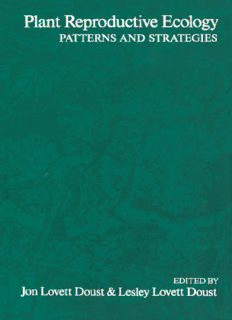
Plant Reproductive Ecology: Patterns and Strategies PDF
Preview Plant Reproductive Ecology: Patterns and Strategies
PLANT REPRODUCTIVE ECOLOGY This page intentionally left blank Plant Reproductive Ecology PATTERNS AND STRATEGIES Edited by JON LOVETT DOUST and LESLEY LOVETT DOUST New York Oxford OXFORD UNIVERSITY PRESS Oxford University Press Oxford New York Toronto Delhi Bombay Calcutta Madras Karachi Petaling Jaya Singapore Hong Kong Tokyo Nairobi Dar es Salaam Cape Town Melbourne Auckland and associated companies in Berlin Ibadan Copyright © 1988 by Oxford University Press First published in 1988 by Oxford University Press. Inc., 200 Madison Avenue, New York, New York 10016 First issued as an Oxford University Press paperback, 1990 Oxford is a registered trademark of Oxford University Press All rights reserved. No part of this publication may be reproduced, stored in a retrieval system, or transmitted, in any form or by any means, electronic, mechanical, photocopying, recording, or otherwise, without the prior permission of Oxford University Press, Ine. Library of Congress Cataloging-in-Publication Data Plant reproductive ecology : pattern and strategics / edited by Jon Lovctt Doust and Lesley Lovett Doust. p. cm. Includes index. ISBN 0-19-505175-0 ISBN 0-19-506394-5 2468 109753 Printed in the United States of America This book is dedicated to David Lloyd in appreciation of his theoretical insights, empirical investigations, and generosity of spirit. This page intentionally left blank Preface Our aim in editing this volume has been to produce a cohesive series of synthetic reviews of the field of plant reproductive ecology. These up-to-date accounts appraise past work and seek to highlight new and exciting research fronts. The book is intended for researchers in the discipline of plant reproductive ecology and those just entering the field. The first seven chapters present a critical discussion of important conceptual issues. The next five chapters cover particular biotic interactions shaping the evolu- tion of plant reproductive strategies. The final three, taxonomically based chapters, review the reproductive ecology of the major non-angiosperm plant groups. We are very grateful to the colleagues who kindly assisted by reviewing particular chapters. Peter Alpert and Robert Nakamura were especially helpful in this regard; in addition we are grateful to Robert Edyvean, Henry Ford, Tom Lee, David Mulcahy, and Jennifer Ramstetter. Authors of individual chapters make their own acknowledg- ments; we would simply add our appreciation of the spirit of cooperation and enthu- siasm that has grown from this shared venture. South Hadley, Mass. J. L. D. June 1987 L. L. D. This page intentionally left blank Foreword George C. Williams recently wrote that "Historians may one day marvel at the tar- diness of the realization that life history attributes are subject to natural selection, and evolve no less than teeth and chromosomes.... I attribute this tardiness to a persis- tent and widespread failure to make full use of the Mendelian formulation of natural selection. What is sometimes called modern Darwinism is a field in its infancy, at best." Jon and Lesley Lovett Doust's Plant Reproductive Ecology: Patterns and Strat- egies, with a dozen and a half first-rank authors, aims to place the study of the evo- lution of plant reproduction at least in toddlerhood. In the same way that two to three- year-old children challenge their parents (and themselves) with their blend of depen- dency and zeal for exploration, so does this field mix the old with what "might be the new." A fuller use of the "Mendelian formulation of natural selection" has made us keenly aware of new possibilities in plant reproduction. The fact that pollen and ovules contribute equal numbers of chromosomal genes to seeds leads immediately to the question of how male (pollen) reproductive success influences floral characters and many other aspects of plant reproduction. Historians may one day wonder why this broad question was not posed until the late 1970s. Although male fertility is hard to measure (compared to counting seeds) this does not explain the virtual absence of speculation on the importance of the male role in most plant biology texts, which often seem to imply that plants attract pollinators in order to set seed. Further use of Williams's "natural selection on life histories" question has led to even more subtle possibilities. Whereas many plant reproductive features (e.g., dioecy) have been viewed classically in a Panglossian fashion as regulators of inbreed- ing, now we are not so sure, and we ask how the features might have been molded by natural selection operating on differential opportunities for male and female repro- duction. Whereas seed provisioning has been assumed to represent a strategy employed by the maternal plant to balance offspring size and number, we now realize that mother, father, and offspring have somewhat different interests in the reproduc- tive allocations. The various reproductive tissues present in the ovary can be viewed as close relatives, able to influence each other's reproduction and therefore subject to kin selection. As surprising as some of these suggestions might seem at first, the great- est surprise is how simply Darwinian they are; they follow almost automatically from the use of "the Mendelian formulation of natural selection." Of course ecology is also a key word. As they grow, plants compete for light, nutrients, space, time, and water. Fruits and seeds face the often conflicting demands of dispersal and predator escape. The authors of this book never forget that the plant's
Description: